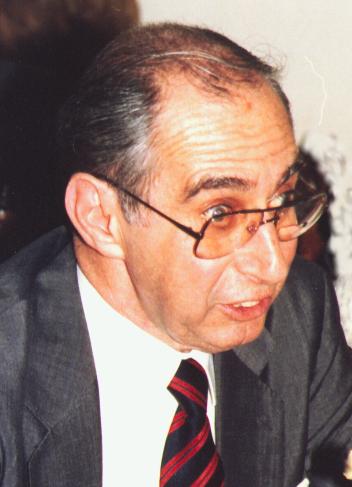Peter Mazur, 1922-2001

|
In 1951, Mazur obtained his doctorate under the direction of Sybren de Groot with a thesis entitled, "Thermodynamics of Transport Phenomena in Liquid Helium-2." The results were in good agreement with experiments done at the Kamerlingh Onnes Laboratory in Leiden, the Netherlands.
After many futile attempts to obtain a theoretical foundation for experimentally established reciprocal relations, Lars Onsager finally (in 1931) showed that such relations were a general consequence of the invariance of the microscopic equations of motion under time reversal. Josef Meixner in 1941 and, independently, Ilya Prigogine in 1947 set up a consistent phenomenological theory of irreversible processes, incorporating both Onsager's reciprocity theorem and the explicit calculation for some systems of the so-called entropy source strength. Shortly thereafter, Mazur and de Groot joined this group as founding fathers of the new field of nonequilibrium thermodynamics.
After a period as a postdoctoral fellow at the University of Maryland, College Park, Mazur became an associate professor at Leiden University in 1954. He and de Groot, who had also moved to Leiden, founded, in 1955, the Lorentz Institute for Theoretical Physics at Leiden University. In 1961, Mazur became a full professor, and when de Groot left in 1963, he became director of the institute. He filled this position in his own distinctive way for 25 years until he became emeritus in 1988. Under the direction of de Groot and Mazur, the institute grew substantially and eventually established the Lorentz Chair, a prestigious special professorship.
In his first years at Leiden University, Mazur studied the classical and quantum molecular foundations of nonequilibrium thermodynamics. Significant results included the derivation of the Langevin equation with one of us (Oppenheim) and the classic paper on harmonic oscillator systems by George Ford, Mark Kac, and Mazur, which was published in the Journal of Mathematical Physics (in 1965). Mazur's work in the 1950s and 1960s culminated in the publication of Nonequilibrium Thermodynamics (North-Holland and Interscience, 1962), written by de Groot and Mazur. This book, translated into several languages, became a classic in the field and was later republished in the Dover series of classic monographs.
Mazur's work in subsequent years addressed a variety of problems in statistical mechanics. He had a good nose for problems ripe to be investigated. To describe diffusion of large particles in fluids, he introduced, together with one of us (Bedeaux), the concept of induced forces in 1974. This concept was used to derive generalizations of Faxen's theorem and to develop a theory for the viscosity of a suspension. In 1976, Mazur, with Bedeaux and Alfonso Albano, gave the first systematic formulation of nonequilibrium thermodynamics for surfaces. This formulation opened a new field, which is still in active development. And Mazur, Wim van Saarloos, and Carlo Beenakker developed an algebraic method around 1982 to successfully describe hydrodynamic interactions between arbitrary numbers of particles using induced forces. This was a breakthrough in the field.
After retiring in 1988, Mazur remained active. In 1991, he derived, with Bedeaux, the Langevin equation for a Brownian particle using only causality and time-reversal invariance. From 1994 to 2000, Mazur, together with J. Miguel Rubi, used the method of internal degrees of freedom to describe fluctuations in the context of nonequilibrium thermodynamics. In 2001, he and Bedeaux developed nonequilibrium thermodynamics for quantum systems.
Many of Mazur's colleagues and students have good memories of his flamboyant lecture style and the often heated discussions in front of the blackboard. He insisted on a crystal-clear introduction followed by a detailed derivation of the results. And he thoroughly disliked sentences such as, "It can be easily shown that. . . . " It was great to work with him.
Mazur served on the boards of the International Union of Pure and Applied Physics (1966-84) and the Dutch Foundation for Fundamental Research of Matter (1970-85). In 1987, Queen Beatrix made Mazur a Knight of the Order of the Netherlands Lion.
Mazur was an excellent scientist, and superb teacher and colleague, whose knowledge and interests encompassed not only science, but almost all fields of intellectual endeavor. A great man, he was devoted to his family, friends, and colleagues. We will miss him dearly.
Dick Bedeaux (Leiden University)
Irwin Oppenheim (Massachusetts Institute of Technology)
published in Physics Today, March 2002.
...hier is een In Memoriam in het Nederlands...
more memories of Peter Mazur